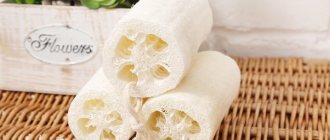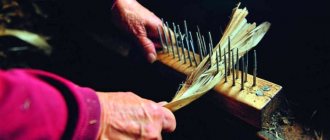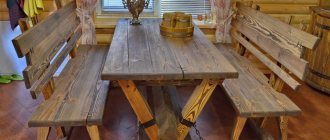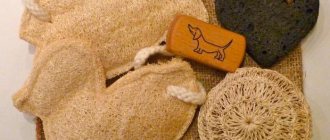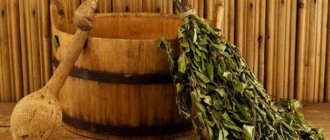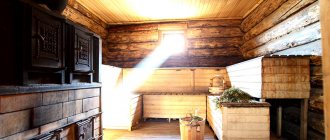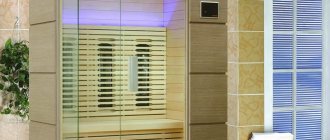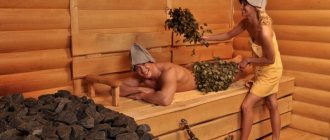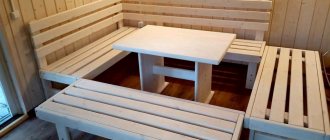There is no way to do without such a necessary thing as a simple washcloth in the household. We simply need it in everyday life. It is impossible to live without it in the bathroom and kitchen. There are many types of washcloths, such as smooth, fluffy, straight, cylinder-shaped, and round. There is a large selection of these products of all types in the trading network, but you can not spend money from your home budget and knit any one you like with knitting needles.
This type of knitting will not require large material costs, because you will only need synthetic threads and knitting needles (hosiery or with stoppers). In this article you will learn how to knit washcloths of several common types. This is a straight, elongated loop (P), a cylindrical and round pipe. Such products are knitted from fairly stiff synthetic yarn. To conclude the article, we will talk about smooth washcloths knitted using fabric strips.
Washcloth
A sponge is usually a bunch of sponge that is used for bathing. They have recently come into human use. Our ancestors simply soaped their hands or wiped themselves with a cloth. A little later they thought of covering themselves with clay and peeling it off along with the dirt. In the absence of clay, even sand was used. The first hemp washcloths began to be used only at the end of the 19th century.
as a hygiene item
The right washcloth plays an important role in proper body care. It should be thick, soft and absorbent at the same time. A properly selected sponge, while exfoliating the skin, will not scratch the body. Often, in addition to the main function of washing, washcloths help improve a person’s general condition and help overcome illness. It can be a gift for owners, newlyweds and even a baby. This care item can be bought in a store, but you can also tie a washcloth.
Advantages of a knitted washcloth:
- The hostess herself selects the desired pattern and color combination, size and shape.
- The sponge is small, so there will be little time for knitting.
- Yarn consumption is minimal; leftover threads can be used.
- Knitting patterns are simple and do not require much time.
- You can usefully spend your personal time and make the necessary thing.
What are washcloths made of?
Modern industry, like Greece, has everything. That is, almost any household item can be manufactured according to specified requirements and in sufficient quantity. The only problem is the cost and, as a consequence, the final price for the consumer. A mass-produced inexpensive product does not always and completely meet the aspirations and expectations of the user, and in modern realities it is not profitable to make a product with characteristics slightly higher than disposable ones. Production facilities must be loaded, and the buyer must go to buy new goods like going to work. It is simply not profitable for industrialists to do exclusive things. So, we'll do it ourselves. The question is, from what?
Polypropylene thread
A bath sponge made from it is the closest option to samples made in industrial conditions. This material has:
- Low degree of water absorption;
- Hypoallergenic;
- It has fairly good sanitary properties, since microorganisms do not multiply so actively on such material;
- This surface cleanses the skin quite well, having a moderate peeling effect;
- Colors, shapes and sections of threads can be very diverse. Choose - I don’t want;
- Finally, weaving washcloths from such material can be done in the most primitive way - the weave method.
Why might such material not suit the user? First of all, it is synthetic, manufactured by the chemical industry for a wide variety of needs of the national economy, from the manufacture of bag containers, plumbing pipes and ending with plastic cups, so well known to regulars of city liqueurs. How appropriate it is in a traditional bathhouse is up to the individual user and owner to decide.
Wool
We have already talked about the properties of this material in the bathhouse when we discussed in detail the topic of bathhouse caps. Why wool is good:
- This is a natural product that has a certain positive potential and energy. It is unlikely that anyone will argue with this postulate;
- It is well processed and a person who has even basic knitting or crocheting skills will not have much difficulty solving the problem of how to weave a washcloth with his own hands, or, to be more precise, knit;
- It has good cleansing properties, has a gentle effect on the skin, and has a therapeutic effect to improve microcirculation of blood and lymph, both in the superficial layers of the skin and in the deeper ones. Excellent for the regeneration of the epidermis. In the applied aspect, products made from it are convenient to use in the form of a woolen mitten;
- Resistant to water and elevated temperatures, has a sufficient reserve of mechanical tensile strength;
- Finally, the choice of raw materials is quite large and varied, and the price is not scary.
Attention! Woolen products must be dried well after use, since the ability to retain moisture and the natural origin of the raw material can initiate the proliferation of microflora of a different nature, which can result in an unpleasant odor, as the least of evils.
Sackcloth
Referring to the list of materials in which the question of how to weave a washcloth is not necessary in principle, since everything has already been woven before us. Our task is to use burlap to make a bag of a convenient size, usually a square with a side of no more than 180 mm. The edges should be finished with an overlocker, and if it is not available, they should be stitched with a fine double seam. Spontaneous unraveling of the edges of this type of fabric is one of the most serious problems.
Washcloths (photo)
Today, any consumer can find a washcloth of the required shape and color. In everyday life they usually use:
- flat or tubular model with handles at the edges;
- spherical (round);
- mitten;
- heart, rectangle, voluminous sponge;
- fine mesh;
Here is a photo of several types of washcloths.
Knitting washcloths of different shapes
A washcloth for a bath or sauna can have a variety of shapes. If, for example, you knit a one-sided washcloth, you will get a flat product. And if you choose a double-sided one, you will get a voluminous, fluffy handmade washcloth.
The shape of the washcloth depends solely on the decision of the needlewoman, as well as for whom this washcloth will be intended.
The most common washcloths are:
- oval;
- rectangular;
- round;
- curly.
The child will be delighted with a knitted baby washcloth in the shape of animals (hedgehog, cat, etc.). A good option would be to knit a washcloth in the shape of a cartoon character (Smeshariki, SpongeBob, etc.). Here's an example. The photo shows a cute washcloth in the shape of a hedgehog:
How to choose threads?
Let's take a closer look at each type of thread. Among the natural fibers suitable for knitting washcloths are:
- Hemp, made from hemp fibers.
- Jute is made from textile fiber. It makes hard products.
- Bast is rich in phytoncides, but is short-lived.
- Cotton is not very practical for washcloths.
- Wool is often used for washcloths.
- Sisal is obtained from the fibers of agave leaves and is used mainly for washcloths. It has good foaming properties and effectively cleanses the skin, providing a scrub effect.
- Flax fibers are soft, durable and dry quickly, and their qualities only increase over time. Such washcloths have numerous therapeutic and health effects on the body.
Knowing the disadvantages of natural materials, housewives still prefer synthetic fibers:
- Nylon and nylon threads, which are often used to strengthen wool. Often unwearable tights and stockings are turned into original peeling items.
- Polyethylene, ribbons of plastic bags make high-quality bath accessories.
- Viscose.
- Acrylic fibers.
- Polypropylene, the most practical and popular material for needlework.
- Rubber (rubber), today chemists have learned to produce rubber yarn, although it is rare on sale.
- Polypropylene yarn, which has increased strength. It is convenient to work with, and knitted products take good care of the body. Today, housewives have begun to combine polypropylene thread with other types of yarn, so the products come out soft and durable. Often in master classes, when knitting, pieces of foam rubber are inserted inside to give the washcloth softness.
How to knit a washcloth with elongated loops for beginners
When creating such a model, it is enough to know the basic basics of creating “shaggy” loops. Let's look at the process step by step:
- First you need to create a chain using air loops (VP).
- After going through 3 rows with a single crochet (SC), we make a VP, then repeat the SC.
- By inserting the hook into the previous row, we create a loop.
- Picking up the thread from below with your finger, we make a large ring.
- Then, after threading the hook through the loop of the fabric, we grab the thread and pull it through. Grab the working thread again and pass it through three loops.
- We knit until we get the fabric of the desired size.
Knowing the stages of knitting elongated loops, you can start creating a bath accessory:
- We will connect a row of VPs into a circle. Its size will determine the width of the washcloth. Usually 40 loops are made.
- Having knitted 7 rows of STBN, we make elongated loops in the 8th row. They should remain on the wrong side.
- The length of the washcloth is determined by the craftswoman herself.
- We complete the work by knitting several rows of STBN, then collecting them in a circle.
- We make handles from a chain of loops. Their length is determined independently.
- The product is turned inside out and must be washed. To make the accessory soft, be sure to pour boiling water over it.
Personalized washcloths
As a gift for any holiday, you can make your own washcloth with a name or any memorable inscription for your mother, grandmother or any dear person. Next, we will consider the process of crocheting a round or rectangular washcloth with elongated loops with a double-sided inscription.
To work, you need to prepare yarn of two shades. For the main fabric, you can take a whole skein, but for the inscription you need very little thread; it can be made from leftover yarn.
The strap and handle for such a washcloth can be knitted from yarn to match the inscription.
This video shows how to knit letters on the main fabric. You can choose any shape of the washcloth, rectangular, square, or oval.
Round washcloth with elongated loops
The question often comes up on the Internet: “Is it possible to learn how to knit a washcloth just from a video?” Of course, even beginners can do such a task. All steps of creating an accessory are reproduced step by step on the screen. For convenience, we additionally place a pattern for knitting a washcloth.
Each craftswoman determines the required number of rows individually. The edges of the product can be sealed by knitting 2-3 rows of STBN and 2 loops together (alternating).
Ready-made knitted washcloths and mittens: photos, assortment, prices
If for some reason you cannot/don’t want/don’t know how to knit items for baths and showers, you can buy washcloths and mittens on our website. The washcloths are knitted from polypropylene and natural yarn. Prices for washcloths and mittens depend on the complexity of knitting and the cost of yarn.
Here you will find several models of washcloth mittens that you can buy. Availability is indicated under each photo. Orders for knitting washcloths and mittens are not accepted. We sell washcloths that are in stock. The number of finished products is indicated under each photo.
Please ask all questions about purchasing ready-made handmade washcloths using the return form. I will answer you in PM.
Crochet washcloth mitten
The bath mitten is knitted similarly to a regular mitten. The only difficulty arises when creating the thumb, but it can be omitted. For work, take threads of sisal or flax, but nylon will cause excessive rigidity. To make the product attractive, use bright yarn.
- For a large palm we create a chain of 30 VPs or 20-25 for a small one.
- We continue to work with single crochets in a circle.
- Moving to a new row, knit 1 VP.
- Having reached the desired size, connect the top of the mitten with STBN.
- Fasten the thread.
For babies, washcloths are made from flax threads by analogy. Knitting patterns greatly simplify the work.
Practical crocheted washcloth without loops
To knit a bath accessory without loops, you need to stock up on:
- yarn;
- crochet number 5.
The process consists of the following steps:
- loops are cast on the instrument - an even number;
- then they are connected into a ring;
- one air lifting loop is knitted;
- a row of single crochets is performed;
- two more air lifting loops are knitted;
- a double crochet row is performed;
- in this way the washcloth is knitted until the desired size is obtained;
- handles are knitted - a chain is made of air loops and fixed on the opposite side, after which it is tied with posts, the thread is cut and secured with a knot.
That's all the manipulation. Is it difficult? Of course not. This accessory paired with a unique handmade hat will definitely please your man.
Multi-colored propylene washcloths
It is no secret that knitting, in addition to perseverance and desire, requires certain skills from the craftswoman. We look for them in books or find them on the pages of magazines. Today, it is enough to open the Internet, ask a question in a search engine, and the required answer will appear on the monitor screen. Even if a crochet hook has just appeared in your life, with the help of the “DIY” resource you will quickly master the technique of knitting a multi-colored washcloth.
Crochet dishwasher
Every housewife knows how often she has to change her kitchen sponge. Why not knit it yourself? Only 20 g of synthetic yarn will be needed to create such an item. When knitting, you can combine the colors of the threads.
Option 1:
- Using hook number 5 we create 50 VP.
- We knit 4 rows (knit and purl) STBN. The tape comes out wide.
- Then we fold the canvas so that the smaller edge overlaps the larger one.
- Place the long end under the ring and weave the entire ribbon in a circle.
- We sew the edges.
2nd option:
- Having collected 20 VPs from a synthetic thread, we connect them into a circle.
- Let's make 10 rows of STBN. We will hide a piece of foam rubber inside.
- Let's add 10 more rows and finish the job.
Patterns of crocheted washcloths
If you have a clear diagram, the task of how to crochet a washcloth yourself for beginners can be solved quickly. Single, flat, for a bath, for children - the choice is great. A creative craftswoman will unleash her imagination and create a magnificent thing for taking a bath, shower, or visiting the sauna. A diagram for knitting the product will help explain the whole theory of creating a washcloth.
How to crochet a strawberry?
If you want to add a bright strawberry note to your bathroom, then start knitting a “delicious” strawberry washcloth. Red and green polypropylene thread is suitable for it. If the item is intended for children's skin, take a softer yarn. For a strawberry (12 x 18 cm), a tiny piece of foam rubber is needed for filling.
- Having dialed 3 VPs, we close them in a ring, and from the center we take 6 STBN.
- Gradually add 6 loops per row.
- Let's create elongated loops in a circle. Having collected 10 rows, put the foam rubber and begin cutting the loops (two together) until the ring closes.
- Using the diagram, we will make 6 green leaves and a red flower. Carefully sew the parts to the top of the product.
- From 20 VP we will make a loop.
We crochet a round washcloth in a step-by-step master class with diagrams
Since ancient times, people have resorted to various objects to take care of themselves that could replace a washcloth: tufts of grass, mosses, pebbles. Today, the developed trade industry offers a huge variety of washcloths, all kinds, shapes, colors. But at the same time, nothing prevents any family from having homemade knitted individual washcloths for each family member. After all, homemade products can take into account a person’s individual preferences in the hardness, shape, length and color of the washcloth. To knit a washcloth you only need a hook, thread and a little time. In this article we will look at several simple models of washcloths that anyone can knit if desired.
You should not use acrylic or wool yarn to knit washcloths. It is better to take threads made from natural materials such as twine, sisal, and linen threads. And for knitting waterproof and brightly colored items, the most common material is considered to be artificial polypropylene thread. The color scheme depends on the tastes and preferences of the needlewoman and who the washcloth is intended for.
When knitting, it is advisable to achieve loose knitting, since then the washcloth will be softer, more flexible and lathers well. You can tie a bulky washcloth and put a piece of soap and foam rubber inside. Then it will be convenient to use.
When knitting, it is better to choose a hook No. 5-No. 7, since a thinner tool will produce a denser and stiffer product.
Using this pattern, experienced knitters can easily make a round washcloth.
And for those who need more detailed instructions, this example of knitting round washcloths is offered.
- First, we cast on 6 air loops. We close it into a ring. We knit the next row with double crochets - 12 stitches. To make the washcloth fluffy, you can knit one regular stitch, and the next with an elongated loop.
- Third round: double crochet - two from each loop.
- Fourth round: knit without increments.
- We knit the following circles, alternating knitting: 1 row *double crochet*, 2nd row *single crochet*. Thanks to this knitting, the product will turn out flat and round, and will not bend.
- Penultimate round: From one loop, make two double crochets. From the next loop, knit only one stitch.
- Last round: knitted by alternating two double crochets from one base and two chain stitches.
- We tie and tie the handle.
It turns out to be such a washcloth.
Knitting patterns
Using patterns for knitting washcloths in your work, you can create different models of bath accessories.
Scheme 1: Oval model
Diagram 2: Round model
Scheme 3: Elongated loops can be made not only with your finger, but also with a school ruler.
